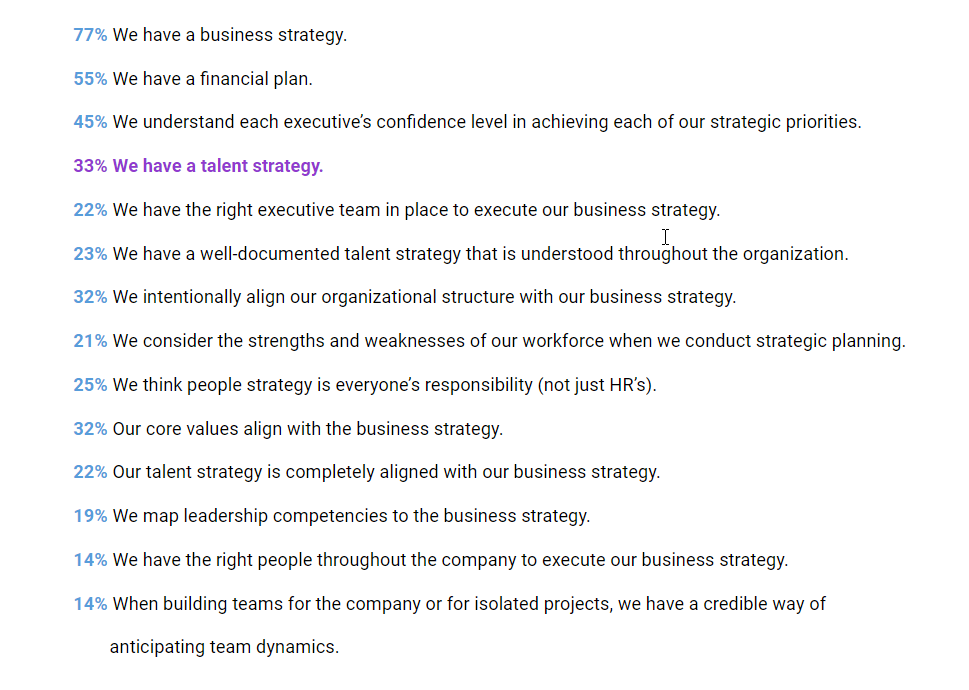In the 2020 State of Talent Optimization Report, our researchers surveyed 600 CEOs and VPs. Those polled included 73 executives from the business and professional services industry. The goal: to understand the role talent strategy plays in delivering business results.
The findings were clear: Talent strategy can be a differentiator for your business. But only if you actually have one.
Here were seven key findings from the business and professional services sector:
1. 67% of total costs are labor (people) costs.
Researchers asked executives to assign a percentage of their total company costs to employee-related/labor costs.
Across all industries, people were a company’s biggest expense. But this was even more pronounced in business and professional services. The average company in the industry spends 67% of its costs on its employees (line items such as salary and benefits).
Given the various complexities of professional service jobs—from accounting to architecture—it makes sense why employees would be so expensive. All the more reason why defining and executing a talent strategy is so critical.
2. 76% of company value is attributed to employees.
Business and professional services execs also shared what percentage of their company’s value they directly attribute to employees: 76%.
In other words, over three-quarters of a company’s value comes from the people who work there. Not only are those in professional services well-compensated for their work—they’re also the biggest drivers of organizational success.
Defining a talent strategy, then, is good resource management. Especially as competition in areas like consulting and law makes it tough to retain top performers.

3. 33% of professional services companies have a talent strategy.
People are your most expensive and most valuable assets. Yet only 33% of business and professional services companies have a talent strategy.
We presented executives with a list of 14 statements and asked them to check all that were true for their company. Most companies had a business strategy, and slightly more than half had a financial plan. But only one in three business and professional services companies had a talent strategy in place.

Investing in talent strategy may seem trivial, especially when clients are your top priority. But when left unaddressed, poor talent management can lead to bad customer experiences—and negatively affect your bottom line.
4. Professional services execs say talent strategy is their top priority.
Despite the scarcity of talent strategy in the professional services industry, 36% of the execs polled say it’s their No. 1 priority for 2020.
When asked to share their top priority for 2020, the panel of business and professional services executives chose one priority from a list of six options. The most common answer was Talent strategy: How you hire, organize, and manage your people (36%) followed by Strategy development: Building the right business strategy year after year (27%).
Why focus on talent strategy? In areas like law and consulting, effective use of talent is particularly important. If you have salaried employees who don’t work the requisite billable hours, you’re burning money. Or maybe you want to limit turnover caused by the stress of the job or lack of career growth opportunities.
Regardless of the reason, it’s clear execs seek ways to build a winning strategy. Ideally, the senior team crafts such a well-defined strategy, it becomes the blueprint for the company so employees can handle the operational execution themselves. You can see this in consulting, where employee specialization and talent management are considered particularly important.
5. 23% of professional services companies have a well-documented talent strategy that is understood by everyone.
Whereas 33% of business and professional services execs said their company has a talent strategy, just 23% said We have a well-documented talent strategy that is understood throughout the organization. In an industry where systems and documentation are so critical to success, the lack of a clear talent strategy is cause for concern.
A strategy must be well-documented to be actionable. If it’s not articulated on paper, it can’t be shared with employees, partners, or customers.
Join 10,000 companies solving the most complex people problems with PI.
Hire the right people, inspire their best work, design dream teams, and sustain engagement for the long haul.
6. 12% of professional services companies align business strategy with talent strategy.
Only nine of the 73 business and professional services executives surveyed selected all three of the following statements:
- We have a talent strategy.
- We have a business strategy.
- Our talent strategy is completely aligned with our business strategy.
The discipline of talent optimization argues that companies must define both a business strategy and a talent strategy and align them to be mutually beneficial.
Employing these practices doesn’t guarantee results. But doing so certainly increases your odds of success.
7. Only 19% of professional services execs consider talent strategy a shared responsibility.
Too often, it’s HR that’s tasked with creating and implementing a comprehensive talent strategy. HR certainly can—and should—play a role, but you’ll need to hear from voices across the company to form a healthy, lasting talent strategy.
Only 25% of business and professional services executives surveyed said We think people strategy is everyone’s responsibility (not just HR’s).
Why the disconnect? In professional services, it’s easy for senior leaders to have their hands full with business operations. HR can become a common crutch for handling any and all things people. Unfortunately, this can cause an unintentional breakdown in communication between the two groups. And when communication fails, it becomes exceedingly hard to map the talent strategy back to the business.
Share these statistics with a co-worker at your company.
The only way to affect change is to get the conversation started. Share these stats during your next company all-hands. Work them into a slide deck for a weekly team meeting. Or bring them up during a 1 on 1 with your manager.
The 2020 State of Talent Optimization Report polled respondents from over 20 industries, including professional services, health care, education, energy, and technology. Explore the full 60-page report here.








